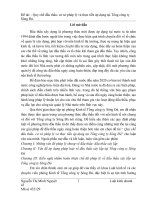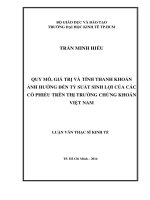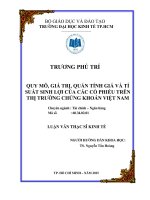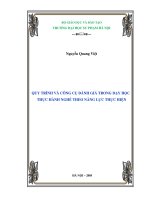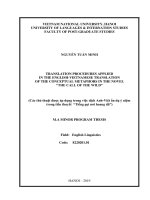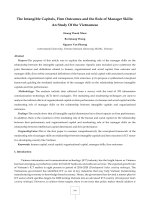Luận văn thạc sĩ quy nhon university 3rd year english majors perceptions of online learning of speaking skills
Bạn đang xem bản rút gọn của tài liệu. Xem và tải ngay bản đầy đủ của tài liệu tại đây (970.58 KB, 135 trang )
MINISTRY OF EDUCATION AND TRAINING
QUY NHON UNIVERSITY
TRINH MINH NHUT
QUY NHON UNIVERSITY 3RD-YEAR ENGLISH
MAJORS’ PERCEPTIONS OF ONLINE LEARNING
OF SPEAKING SKILLS
Field: Theory and Methodology of English Language Teaching
Code: 8140111
Supervisor: Assoc. Prof. Dr. Nguyen Quang Ngoan
Binh Dinh - 2022
BỘ GIÁO DỤC VÀ ĐÀO TẠO
TRƯỜNG ĐẠI HỌC QUY NHƠN
TRỊNH MINH NHỰT
NHẬN THỨC CỦA SINH VIÊN NĂM THỨ BA
CHUYÊN NGÀNH TIẾNG ANH TRƯỜNG ĐẠI HỌC
QUY NHƠN VỀ VIỆC HỌC KỸ NĂNG NĨI
THƠNG QUA HÌNH THỨC TRỰC TUYẾN
Ngành: Lý luận và phương pháp dạy học bộ môn Tiếng Anh
Mã số: 8140111
Người hướng dẫn: PGS. TS. Nguyễn Quang Ngoạn
Bình Định - 2022
i
STATEMENT OF AUTHORSHIP
I confirm that the work presented in this research report has been
performed and interpreted solely by myself except where explicitly identified
to the contrary. I confirm that this work is submitted in partial fulfilment for
my M.A. degree in Theory and Methodology of English Language Teaching
and has not been submitted elsewhere in any other form for the fulfilment of
any other degree or qualification. This paper does not contain any material or
content previously published or written by another paper or anyone else.
Binh Dinh, August 2022
Trinh Minh Nhut
ii
ACKNOWLEDGEMENTS
Without the great assistance of my supervisor, Assoc. Prof. Dr. Nguyen
Quang Ngoan, this work would not have been achievable. I am deeply
indebted to my supervisor since from the research proposal to the final
version of this report, his vast knowledge, practical experience in the field,
great enthusiasm and meticulous attention to detail have been an inspiration
and kept me on track.
I would like to offer my special thanks to those who participated in my
research for their valuable time fulfilling the questionnaire and insightful
information from the interview. If it had not been for their willingness and
enthusiasm, I could not have collected important data for my study.
My deepest gratitude also extends to all of my wonderful classmates for
the time we shared as well as the information and experience we gained from
one another. Their continuous support and encouragement mean a lot to me in
the accomplishment of this study.
Last but not least, my family members have been tremendously
significant to me in the pursuit of this project. I would like to express my
gratitude to my parents, who have always supported and guided me in my
endeavors. They are the definition of positive role models.
iii
ABSTRACT
During the social distancing period in Vietnam due to the Covid-19
pandemic, online learning was implemented as an emergency replacement for
traditional, face-to-face teaching and learning. Research in the field of online
learning has been done extensively, yet not much focuses on investigating
university students’ perceptions of learning English speaking skills online.
This study hence employed Collins and Berge (1996)’s criteria for the success
of online learning to collect quantitative and qualitative data from 100 Quy
Nhon University 3rd-year English majors. Descriptive design was mainly used
since the primary aim of the study is to find out students’ perceptions of the
benefits and challenges of online learning of speaking skills. The
questionnaire’s results demonstrate that students show more positive
responses toward the benefits than the challenges. The interview data is not
only consistent with the questionnaire data but also uncovers new and
interesting results. These findings provide a better understanding of the
context of online learning during the Covid-19 pandemic which serves as a
guide for the optimization of this type of teaching and learning in the new age
of technology.
Keywords: online learning, speaking skills, benefits, challenges,
descriptive, English majors
iv
TABLE OF CONTENTS
STATEMENT OF AUTHORSHIP ................................................................... i
ACKNOWLEDGEMENTS .............................................................................. ii
ABSTRACT ..................................................................................................... iii
TABLE OF CONTENTS ................................................................................. iv
LIST OF ABBREVIATIONS ......................................................................... vii
LIST OF TABLES ......................................................................................... viii
LIST OF FIGURES.......................................................................................... ix
CHAPTER 1: INTRODUCTION ..................................................................... 1
1.1 Research rationale ................................................................................... 1
1.1.1 Theoretical reasons........................................................................... 1
1.1.2 Contextual reasons ........................................................................... 2
1.2 Aim and objectives of the study .............................................................. 3
1.3 Research questions .................................................................................. 3
1.4 Scope of the study ................................................................................... 4
1.5 Significance of the study ......................................................................... 4
1.6 Definitions of important terms ................................................................ 5
1.6.1 Online learning ................................................................................. 5
1.6.2 Speaking skills ................................................................................. 5
1.6.3 Context of online learning at Quy Nhon University ........................ 5
1.7 Structure of the thesis .............................................................................. 6
CHAPTER 2: LITERATURE REVIEW .......................................................... 8
2.1 Online learning ........................................................................................ 8
2.1.1 The overview of online learning ...................................................... 8
2.1.2 Online learning in Vietnam during the Covid-19 pandemic.......... 11
v
2.1.3 Computer-mediated communication (CMC) ................................. 11
2.1.4 The role of the instructor/ teacher in an online classroom ............. 15
2.1.5 Teachers and students’ perceptions of online learning .................. 16
2.2 Online learning of speaking skills ......................................................... 18
2.2.1 Speaking skills ............................................................................... 18
2.2.2 Challenges facing learners in the online learning of speaking skills
during the Covid-19 pandemic ................................................................ 22
2.3 Previous related studies ......................................................................... 24
Chapter 3: METHODOLOGY ........................................................................ 31
3.1 Research approach ................................................................................ 31
3.2 Participants ............................................................................................ 32
3.2.1 Research setting ............................................................................. 32
3.2.2 Sampling technique ........................................................................ 33
3.3 Instruments ............................................................................................ 34
3.3.1 The questionnaire ........................................................................... 35
3.3.2 The interview ................................................................................. 36
3.4 Procedure............................................................................................... 37
3.4.1 Pilot study....................................................................................... 37
3.4.2 Data collection ............................................................................... 38
3.4.3 Data analysis .................................................................................. 40
CHAPTER 4: FINDINGS AND DISCUSSION ............................................ 42
4.1 Findings from the questionnaire ........................................................... 42
4.1.1 Comparison of the two majors ........................................................... 42
4.1.2 Students’ devices used for online learning of speaking skills ....... 43
4.1.3 Students’ perceptions regarding the benefits of online learning of
speaking skills ......................................................................................... 44
4.1.4 Students’ perceptions regarding the challenges of online learning of
vi
speaking skills ......................................................................................... 55
4.2 Findings from the interview .................................................................. 69
4.2.1 Students’ perceptions in terms of the benefits of online learning of
speaking skills – Interview results .......................................................... 69
4.2.2 Students’ perceptions in terms of the challenges of online learning
of speaking skills – Interview results ...................................................... 74
CHAPTER 5: CONCLUSION........................................................................ 80
5.1 Summary of key findings of the study .................................................. 80
5.1.1 Students’ perceptions of the benefits of online learning of speaking
skills ......................................................................................................... 80
5.1.2 Students’ perceptions of the challenges of online learning of speaking
skills ......................................................................................................... 81
5.2 Pedagogical implications ...................................................................... 82
5.3 Limitations and suggestions for further research .................................. 83
REFERENCES ................................................................................................ 85
APPENDICES............................................................................................... 101
APPENDIX 1: QUESTIONNAIRE.......................................................... 101
APPENDIX 2: INTERVIEW QUESTIONS ............................................ 105
APPENDIX 3: INTERVIEW TRANSCRIPTION ................................... 106
APPENDIX 4: SPSS STATISTICS .......................................................... 123
vii
LIST OF ABBREVIATIONS
CMC:
Computer-mediated Communication
EFL:
English as a Foreign Language
EL:
English Language
ERT:
Emergency Remote Teaching
ESL:
English as a Second Language
ETE:
English Teacher Education
ICT:
Information and Communications Technology
MOET:
Ministry of Education and Training
QNU:
Quy Nhon University
SPSS:
Statistical Package for the Social Sciences software
TAM:
Technology Acceptance Model
UNESCO: United Nations Educational, Scientific and Cultural Organization
VCTs:
Video Conferencing Tools
viii
LIST OF TABLES
Table 1. Participants’ specifications ............................................................... 34
Table 2. Grid of instrument guidelines ........................................................... 37
Table 3. Evaluation Criteria for Likert Scale questions (Tekin, 2000)........... 40
Table 4. Reliability Statistics of the Questionnaire ........................................ 41
Table 5. Means of the questionnaire done by students majoring in EL and
ETE ................................................................................................... 42
Table 6. Difference in perceptions of students majoring in EL and ETE ....... 42
Table 7. Students’ perceptions of the benefits of learning speaking skills
online................................................................................................. 44
Table 8. Benefits of online learning of speaking skills (Open-ended
question) ............................................................................................ 54
Table 9. Students’ perceptions of the challenges of learning speaking
skills online ....................................................................................... 55
Table 10. Other challenges of online learning of speaking skills (Openended question) ................................................................................. 68
Table 11. Results from Interview Question 1 ................................................. 69
Table 12. Results from Interview Question 2 ................................................. 69
Table 13. Results from Interview Question 3 ................................................. 72
Table 14. Results from Interview Question 4 ................................................. 72
Table 15. Results from Interview Question 5 ................................................. 73
Table 16. Results from Interview Question 6 ................................................. 74
Table 17. Results from Interview Question 7 ................................................. 74
Table 18. Results from Interview Question 8 ................................................. 76
Table 19. Results from Interview Question 9 ................................................. 77
Table 20. Results from Interview Question 10 ............................................... 78
ix
LIST OF FIGURES
Figure 1. The proportion of online content delivered in different kinds of
learning - Allen and Seaman (2007, p. 4) ........................................... 9
Figure 2. The percentage of students’ devices used for online learning of
speaking skills ................................................................................... 43
Figure 3. Students’ perceptions of the benefits of learning speaking skills
online - Bar chart .............................................................................. 46
Figure 4. Percentage of Statement 1 ............................................................... 46
Figure 5. Percentage of Statement 2 ............................................................... 47
Figure 6. Percentage of Statement 3 ............................................................... 48
Figure 7. Percentage of Statement 4 ............................................................... 48
Figure 8. Percentage of Statement 5 ............................................................... 48
Figure 9. Percentage of Statement 6 ............................................................... 48
Figure 10. Percentage of Statement 7 ............................................................. 50
Figure 11. Percentage of Statement 8 ............................................................. 51
Figure 12. Percentage of Statement 9 ............................................................. 52
Figure 13. Percentage of Statement 10 ........................................................... 52
Figure 14. Percentage of Statement 11 ........................................................... 53
Figure 15. Percentage of Statement 12 ........................................................... 53
Figure 16. Students’ perceptions of the challenges of learning speaking
skills online - Bar chart ..................................................................... 57
Figure 17. Percentage of Statement 14 ........................................................... 58
Figure 18. Percentage of Statement 15 ........................................................... 59
Figure 19. Percentage of Statement 16 ........................................................... 60
Figure 20. Percentage of Statement 17 ........................................................... 60
Figure 21. Percentage of Statement 18 ........................................................... 61
Figure 22. Percentage of Statement 19 ........................................................... 62
x
Figure 23. Percentage of Statement 20 ........................................................... 62
Figure 24. Percentage of Statement 21 ........................................................... 62
Figure 25. Percentage of Statement 22 ........................................................... 64
Figure 26. Percentage of Statement 23 ........................................................... 64
Figure 27. Percentage of Statement 24 ........................................................... 64
Figure 28. Percentage of Statement 25 ........................................................... 66
Figure 29. Percentage of Statement 26 ........................................................... 66
Figure 30. Percentage of Statement 27 ........................................................... 66
1
CHAPTER 1: INTRODUCTION
This chapter presents the rationale of the study, which includes the
theoretical and contextual background for the study, online teaching and
learning situation and the reasons for conducting the research. Also, details
about the aim and objectives, research questions, scope, significance,
organization and definitions of important terms are introduced.
1.1 Research rationale
1.1.1 Theoretical reasons
Many educational institutions adopted various online teaching formats
during the Covid-19 pandemic epidemic. In anticipation of the decision to end
face-to-face encounters, most Vietnamese universities have turned to online
learning to meet the issue. Online learning is a novel method of delivering
education that makes use of technical instruments such as computers and the
Internet to facilitate the transfer of learning materials (Carliner, 2004, pp. 34). Universities have been able to conduct innovative education with the use
of online learning, either entirely or partially, in recent years as a result of
technology advancements. However, because of the Covid-19 issue,
institutions have been compelled to embrace online learning on a large scale
in order to maintain instruction. Online learning can be divided into three
types of learning environments: synchronous learning, asynchronous learning,
and hybrid learning (Perveen, 2016, p. 27).
Synchronous learning refers to real-time online learning that allows
students and teachers to communicate at the same time or in real-time
(Salmon and Gilly, 2013, p. 5; Shahabadi and Uplane, 2015, p. 131). Video
conferencing, teleconferencing, live chatting, and live-streaming lectures are
all instances of synchronous learning environments. Because teachers may
2
directly observe the learners’ replies during the learning process, the
advantages of synchronous online learning include increased student
engagement and motivation (Hrastinski, 2008, p. 54). This is supported by a
study that found that synchronous learning environments can boost students’
engagement and improve the quality of their learning (Wdowik, 2014, p.
265). In contrast, because it is not constrained by time, location, or classroom,
an asynchronous learning environment allows students and teachers more
flexibility in conducting the learning process (Mayadas, 1997, p. 2).
Asynchronous learning environments help learners and teachers who are
unable to be online at the same time (Hrastinski, 2008, pp. 51-52).
Asynchronous learning environments include email, online modules, virtual
libraries, lecturer’s online notes, lecturer’s blogs, online discussion forums,
and social media platforms. A hybrid learning environment combines
synchronous and asynchronous learning settings to create the best learning
experience possible (Perveen, 2016, p. 21).
1.1.2 Contextual reasons
According to Son (2020), some universities in Vietnam offer online
learning, but it is not available in general education. In a separate statement,
he states that the Vietnamese MOET has been directing and guiding the
online implementation of university and school education for the past few
years. Several institutions have been using online education at various levels
in order to meet their particular training objectives.
UNESCO, in 2020, released its first estimate of the number of students
out of school in early 2020, as a result of the Covid-19 pandemic. The number
of students out of school is estimated to be over 290 million. In reaction to
school closures, they advocate for the use of online learning and open
educational tools, which allow teachers to reach out to students from afar and
3
reduce the danger of disruption in the classroom. To respond to UNESCO’s
appeal to join the global educational mainstream in the face of a pandemic,
most universities in Vietnam, and Quy Nhon University, in particular, have
temporarily turned to online learning. “Even if students have to stay off
school, their learning will not be interrupted” - Vietnamese education has
tried to retain the mentality (Son, 2020).
When there are many conflicting viewpoints from teachers and students
about mandatory online courses during the social distancing period, the idea
for this research arises. The current study hence tries to take focus on
exploring Quy Nhon University English Majors’ perceptions of the benefits
and challenges considering the implementation of online learning of
speaking skills.
1.2 Aim and objectives of the study
This study aims to investigate Quy Nhon University English majors’
perceptions of online learning of speaking skills during the Covid-19
pandemic. The specific objectives are set as follows:
- To explore the benefits of online learning of speaking skills perceived
by Quy Nhon University 3rd-year English majors
- To examine the challenges of online learning of speaking skills
perceived by Quy Nhon University 3rd-year English majors
- To identify the differences in perceptions between the two majors.
1.3 Research questions
1. What are the benefits of online learning of speaking skills perceived
by Quy Nhon University 3rd-year English majors?
2. What are the challenges of online learning of speaking skills perceived
4
by Quy Nhon University 3rd-year English majors?
3. What are the differences in perceptions between the two majors?
1.4 Scope of the study
This study aims to inspect the students’ perceptions of online learning of
speaking skills at the university level. Thus, the questionnaire and the
interview were used to collect data from 100 3 rd-year English majors at Quy
Nhon University, including 50 English Teacher Education majors and 50
English Language majors participating in the survey and 10 students (5 from
English Language majors and 5 from English Teacher Education majors)
taking part in the interview.
1.5 Significance of the study
The findings of the study may provide a profound understanding of the
benefits and challenges regarding online learning of speaking skills at Quy
Nhon University as well as tertiary institutions in general. When there have
been a lot of different viewpoints from teachers and students about mandatory
online courses during the social distancing period, analyzing and shaping the
future of online learning in the university context is supposed to offer
educators useful information so that local and national education may be
implemented in a better and effective way.
As a result, various strategies and solutions may be done to enhance the
benefits and address the challenges faced by university English majors. This
is not only a great help for colleges and universities in the period of Covid-19
but also for those institutions that plan to carry out distance education, which
has been becoming a trend in the new age of technology and communication
where online learning as well as similar forms play a significant role in
learners’ learning experience.
5
1.6 Definitions of important terms
1.6.1 Online learning
Urdan and Weggen (2000, p. 8) describe “online learning” as web-based
learning, internet-based learning, virtual learning, cyberlearning or net-based
learning, which is also referred to as a subset of distance education. Basic
manipulations of online learning courses include “text and graphics of the course,
exercises, testing, and record-keeping” while more complex ones include
animations, simulations, audio and video sequences, peer and expert discussion
groups, online mentoring, linking to material on the web, and communication with
corporate education records (Urdan and Weggen, 2000, p. 8).
1.6.2 Speaking skills
Speaking, according to Richards (2006, p. 28), is defined as displaying
communicative ability by engaging in meaningful dialogue and maintaining
communication. Speaking can be characterized as the most basic form of
human communication (Celce-Murcia, 2003, as cited in Tunc, 2021, p. 21).
1.6.3 Context of online learning at Quy Nhon University
According to the regulations on the management and organization of online
learning approved by the rector of Quy Nhon University on August 6th, 2021:
• Online teaching system is an online teaching software system and
information technology infrastructure (hereinafter referred to as online
teaching technical infrastructure) to manage and organize teaching through
the Internet environment, including online learning software, online learning
management system, online learning content management system.
6
• Online teaching is a teaching activity organized on online teaching
systems.
• Online teaching to support face-to-face teaching is the form of
online teaching that performs part of the lesson content of the university’s
curriculum in the training program to support the face-to-face teaching of that
lesson at the university.
• Online teaching to replace face-to-face teaching is the form of online
teaching implementing the entire contents of the lesson in the training
program and replacing the face-to-face teaching of that lesson at the
university.
1.7 Structure of the thesis
The thesis is presented in five chapters: Introduction, Literature Review,
Methodology, Findings and Discussion, Conclusion and Implications.
Chapter 1, Introduction, presents the rationale, which introduces the
reasons why the researcher chose to conduct the study, the aim and objectives,
the research questions, the scope, the significance, the definition of important
terms and the structure of the thesis.
Chapter 2, Literature Review, examines several underlying theoretical
constructs that framed this study. It also examines the relevant literature
regarding 1) online learning, 2) online learning of speaking skills, 3) the
context of online learning at QNU and 4) related studies on the
implementation of online learning, especially speaking skills.
Chapter 3, Methodology, explains the research methods. Firstly, it
presents the research approach. Secondly, it describes the participants.
Thirdly, it introduces the research instruments used to collect data. Lastly, this
chapter comes to an end with the procedure to conduct the study.
7
Chapter 4, Findings and Discussion, reports the results of the study. First
of all, the reliability of the instruments is introduced. Then, the information
collected from the questionnaire is analyzed. Finally, the data from the
interview is analyzed in order to give an in-depth explanation of the findings
of the study.
Chapter 5, Conclusion and Implications, concludes the report of the
study. First, it summarizes the main findings of the study. Then, it suggests
the research implications. Finally, the limitations of the study and the
suggestions for future research make the last part of this chapter.
8
CHAPTER 2: LITERATURE REVIEW
This chapter presents the main concepts and terms building the
theoretical foundation of the study. In this chapter, online learning, online
learning of speaking skills and the context of online learning at Quy Nhon
University are written and explained in detail. Finally, previous related works
conducted by other researchers are reviewed in terms of their focuses and
findings.
2.1 Online learning
2.1.1 The overview of online learning
2.1.1.1 Definitions of online learning
Different definitions of online learning have been used in studies.
AlHamad et al. (2014, p. 7) see online learning as an advantage since it
allowed students to study at home. Dabbagh and Bannan-Ritland (2005, as
cited in Van and Thi, 2021, p. 3) identify the physical presence of teachers
and students in physical classrooms at a set time, with teachers’ linear
teaching methods being replaced by online learning, which is all dynamic,
unbound, and the practice of pedagogical active learning and learner-centered
approach (Browne, 2005, p. 58). Other researchers classify online learning
based on the flexibility of the classes (Atack, 2003, p. 294; Fish, 2017, p. 20;
Horspool and Lange, 2012, p. 75; Platt et al., 2014, p. 490), the convenience
with and without family issues and/or health problems (Dyrbye et al., 2009, p.
42; Kokko et al., 2015, p. 64) and the expansion and popularity (Landrum et
al., 2021). From a different perspective, Urdan and Weggen (2000, p. 8)
describe “online learning” as web-based learning, internet-based learning,
virtual learning, cyberlearning, or net-based learning, which is also referred to
as a subset of distance education. Basic manipulations of online learning
9
courses include “text and graphics of the course, exercises, testing, and
record-keeping while more complex ones include animations, simulations,
audio and video sequences, peer and expert discussion groups, online
mentoring, linking to material on the web, and communication with corporate
education records (Urdan and Weggen, 2000, p. 8). As a result, online
learning focuses on both online learning content and the obvious use of
technology to deliver relevant and successful lessons. Allen and Seaman
(2007, p. 4) identify the four primary types of learning based on the quantity
of online content given. Traditional learning sees no contribution of supplied
content (0%), but a Web-facilitated strategy allows for a percentage of 1% to
29% delivered online content. Blended or hybrid learning is described as
transferring 30% to 79% of learning information online, while online learning
is defined as transferring more than 80% of the learning process
electronically. Figure 1 illustrates the situation:
Webfacilitated
• 0%
Traditional
• 1-29%
Online
• 30-79%
• 80%+
Blended/
Hybrid
Figure 1. The proportion of online content delivered in different kinds of learning Allen and Seaman (2007, p. 4)
Campbell (2004, as cited in Van and Thi, 2021, p. 2) claims that the
emphasis of online learning in higher education is on students’ metacognitive
10
growth, such as reflective and collaborative learning. Furthermore, it is
desired to achieve unplanned subject knowledge and learners’ selfdirectedness to optimize incidental learning and boost performance.
2.1.1.2 Opportunities and barriers to implementing online learning
Several
research
investigating
perspectives
of
online
learning
implementation in language learning contexts have been published in recent
years. Studies on the implementation of online learning in Taiwan (Pituch and
Lee, 2006, p. 223), Hong Kong (Lam et al., 2011, p. 1381), Oman (Tanveer,
2011, pp. 5-6) and Egypt (Gamal et al., 2011, p. 2) show that the vast majority
of students have ready access to web-enabled personal computers and web
features, as well as their digital devices. They also make extensive use of
digital and web aspects in their daily life, whether for communication or to
build social networks. Tanveer (2011, p. 1) finds that online learning allows
students to be more autonomous, provides a variety of activities, promotes
intrinsic motivation to learn, helps introvert students interact more effectively,
allows students to gain meaningful study experience and time management
skills, and allows teachers to have a more student-centered form of learning.
Despite its importance, online learning does have some disadvantages.
According to Ku and Lohr (2003), one of the most commonly mentioned
disadvantages of online learning is the technological difficulties students have
when they try to use the Internet. The issues include frequent internet
connection disruptions, delayed loading, and software and hardware
incompatibilities. Furthermore, Keller and Cernerud (2002, p. 65) suggest that
the most visible flaws in the use of online learning are inconsistent usage of
online learning across courses, technological issues, excessive reliance on
computers, and a lack of human interaction.
11
2.1.2 Online learning in Vietnam during the Covid-19 pandemic
Since the emergence of the Internet in the twentieth century, online
learning has existed in Vietnam. However, due to the Ministry of Education
and Training’s (MOET) implementation of online education in Vietnam, its
popularity among students has only recently exploded. In addition, as a result,
numerous colleges and high schools have begun to use this type of learning in
various ways, depending on their educational goals. When the Coronavirus
pandemic hit Vietnam and the rest of the world, the spirit of “continuing to
learn despite school closure” (Nha, 2020) spurred educators and students to
try online learning while also combating the Covid-19 pandemic. It is
possible that the quarantine period in Vietnam during the first quarter of 2020
was the first time that all students had access to online education. This is
essentially a means of combating the virus, but it has nonetheless opened a
new door for Vietnamese education. Chat rooms, polls, quizzes, discussion
boards, and presentations can all be used to help students attain their learning
objectives simply and constructively. Most institutions use Microsoft Teams,
Google Meet, Zoom, Skype, and other learning management systems.
Employing online learning is becoming increasingly important since it
provides
practical
reasons
for
all
stakeholders
to
have
on-time
implementations, particularly to support online learning in the digital age.
2.1.3 Computer-mediated communication (CMC)
When we talk about computer-mediated communication, we are talking
about it in the sense of an umbrella word that encompasses computer-based
training, informatics, and human-to-human communication in the form of
email and computer conferences, according to (Collins and Berge, 1996, p. 3).
In computer-based instruction, the computer (whether networked or not) takes
on the role of patient instructor or tutor, generally on a one-to-one basis and
12
with highly structured and pre-prepared course materials. The computer is
used in informatics to access data from its own data storage media or, in a
networked situation, from remote databases such as online public-access
library catalogues or external file servers and archives, using client
applications such as World Wide Web browsers.
Computer conferencing is a focus within CMC. This can be
accomplished through email and mailing lists, as well as computer
conferencing systems. We use the word “computer conference” in a broad
sense to refer to a wide range of computer-mediated human-to-human
interactions.
2.1.3.1 The advantages and disadvantages of CMC
The benefits of computer conferencing, according to Collins and Berge
(1996, p. 5), include communicating with other students and the instructor
from a distance rather than studying alone. It is possible to create a virtual
community that provides support and encouragement while also encouraging
sharing among participants, which can aid in overcoming the isolation of
remote places. Students can be asked to join the conference with guest
“lecturers”, which allows them to interact directly with specialists in their
fields. It can be quite convenient because it is theoretically as close as the
nearest phone or modem connection. Computer conferencing can take place at
any time and from any location.
According to Collins and Berge (1996, p. 5), the difficulties in acquiring
stable access to a networked computer are the first downsides of computer
conferencing. Students may not see a fair return on their investment due to
high learning curves and time commitments. Technical help is essential
because numerous computer and software setups may or may not
communicate with one another. And just because a student has used
13
computers in the course of their studies does not mean they understand how to
utilize telecommunications software, that they know how to upload and
download files, or that they know how to make folders in their electronic mail
program to store incoming messages. The email looks to be fleeting and
ubiquitous, and convincing participants to accept conference contributions as
“real” and “important” can be difficult. Students in online conferences must
pace themselves, remember to log in regularly, and attend to their course
activities, whereas students in place-based classrooms are used to setting
aside a portion of their lives for travel and attendance in planned classroom
sessions.
To put it simply, social context cues are lacking in conferences, which
might pose issues because humans are accustomed to the high bandwidth of
face-to-face conversations. Misunderstandings can happen rapidly and
resolving them can be difficult and time-consuming. Those who cannot
normally communicate in a face-to-face classroom can do so in the relative
anonymity of internet conferencing.
2.1.3.2 Social media and video conferencing as tools for online learning
During the Covid-19 outbreak, independent study is among the most
prevalent and important ways to learn a language. Learning language skills,
particularly speaking skills, is a hallmark of 21st-century learning for
academic and employability objectives. One of the features is the ability to
apply ICT knowledge, particularly technical expertise, to language acquisition
(Koh et al., 2017, p. 3). Educators should increase their capacity to be more
creative in their use of technology to meet the requirements of their students
in a variety of disciplines. Teaching and learning should not be limited to the
classroom; both instructors and students should use technology to make
language learning materials available. Online learning may provide

